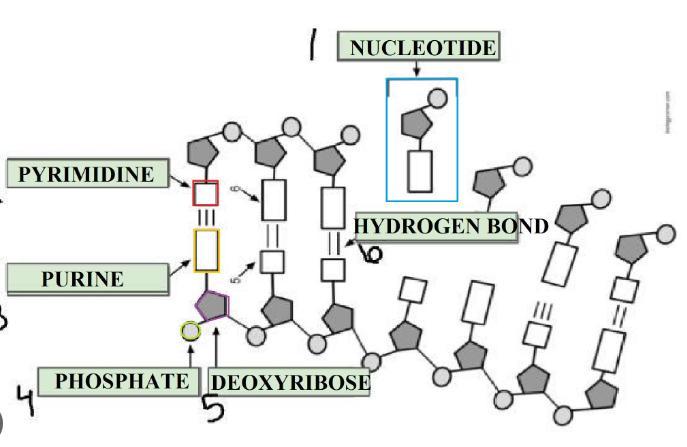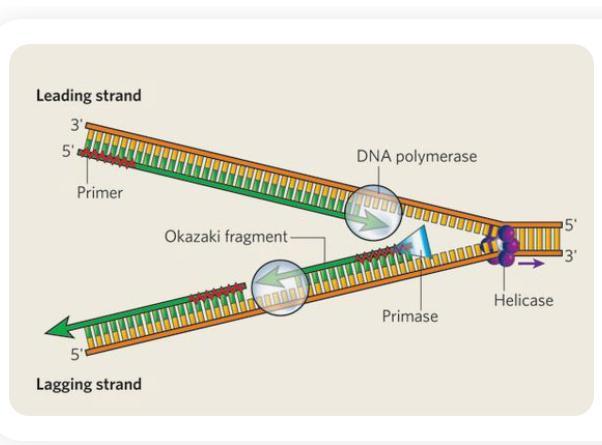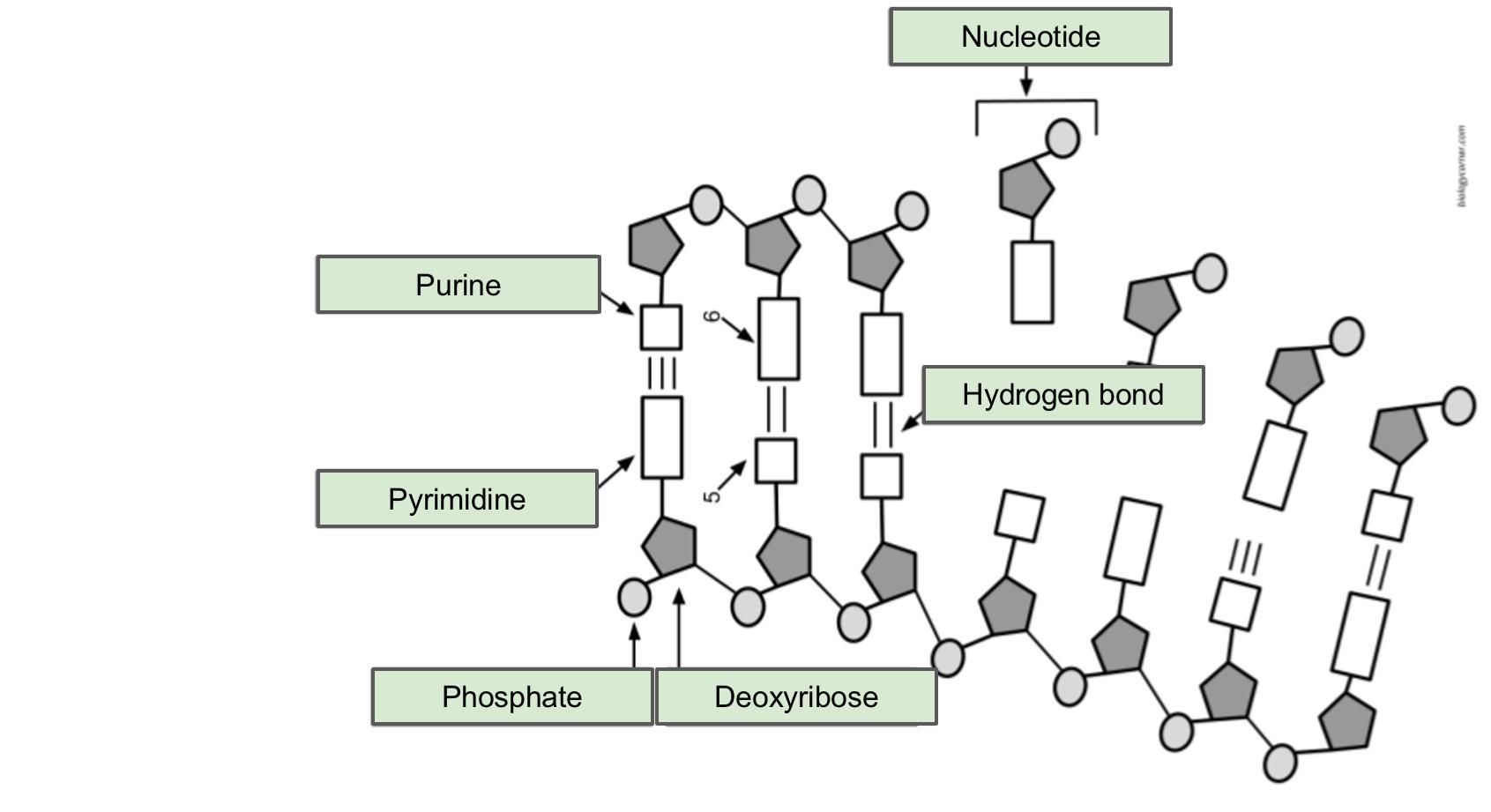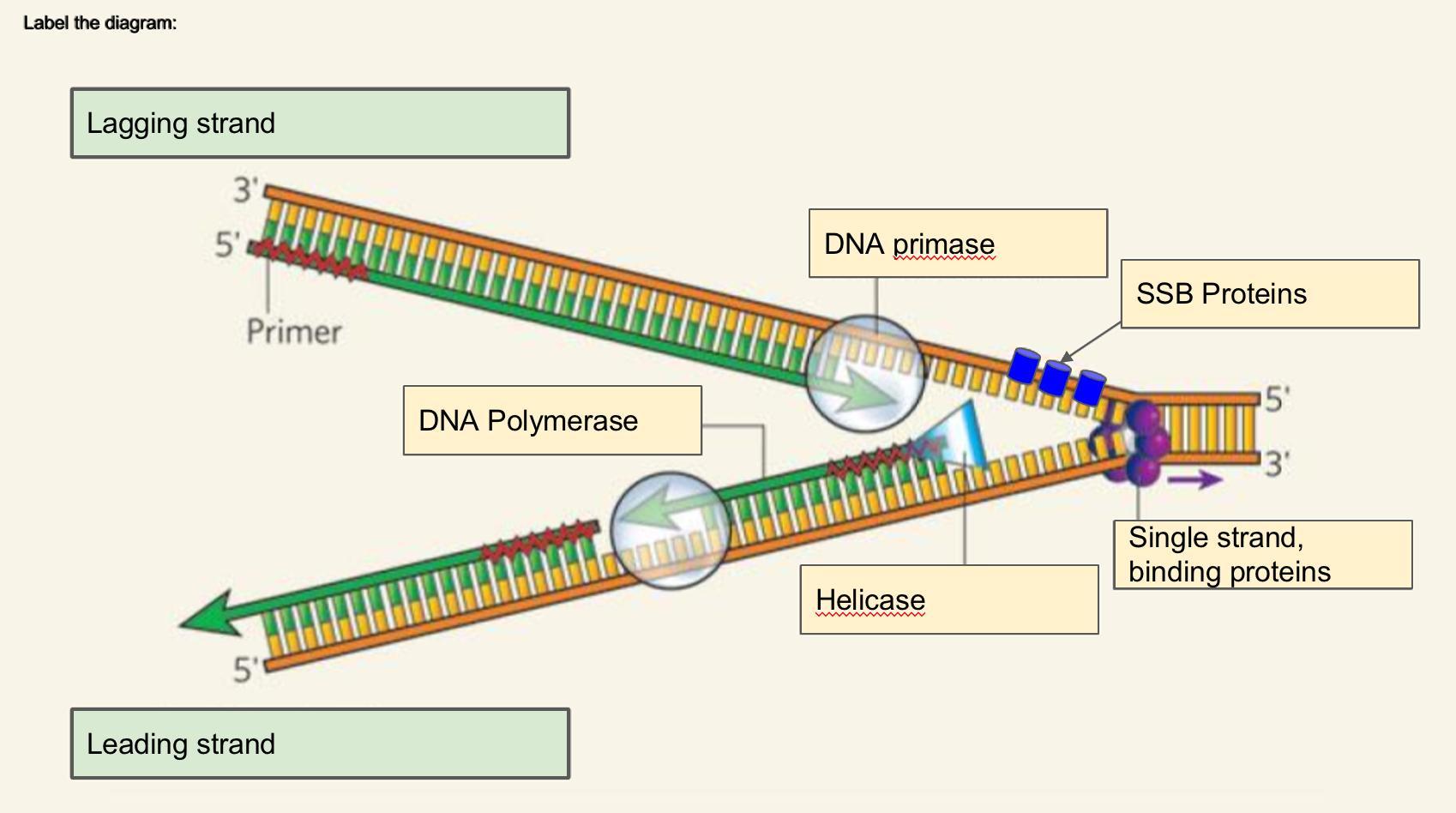Answers
The labelled diagram of structure of DNA and DNA replication has been attached below.
What happens in DNA replication?DNA replication is the process by which a cell copies its genetic material in preparation for cell division. It is a vital process that ensures that each new cell receives an exact copy of the genetic information carried by the parent cell.
The process of DNA replication occurs in the following steps:
Initiation: The DNA double helix is unwound by the enzyme helicase, creating a replication fork where the two strands separate.
Priming: Primase synthesizes short RNA primers along the DNA template strand to provide a starting point for DNA synthesis.
Elongation: DNA polymerase III binds to the RNA primers and begins adding nucleotides to the growing DNA strand in the 5' to 3' direction.
Termination: DNA polymerase I removes the RNA primers and replaces them with DNA nucleotides. DNA ligase then seals the gaps between the Okazaki fragments, joining the newly synthesized DNA strands together.
The process of DNA replication ensures that each new cell receives an exact copy of the genetic information carried by the parent cell. The accuracy of DNA replication is critical to the maintenance of genetic information and the prevention of mutations that can lead to genetic disorders or diseases.
To know more about DNA replication, visit:
https://brainly.com/question/16464230
#SPJ1


Related Questions
Which words from the article help the reader to understand the importance of a special habitat?
OPTIONS
Answers
Answer:
Since there is no specific article mentioned in the question, I will provide a general answer.
The importance of a special habitat can be conveyed through various words and phrases depending on the context. Some examples of words and phrases that may help the reader understand the importance of a special habitat are:
Unique
Endangered
Fragile
Ecosystem
Biodiversity
Rare
Sensitive
Threatened
Niche
Keystone species
Habitat loss
Conservation
Preservation
Sustainability
Irreplaceable
These words and phrases may be used to describe the ecological, scientific, or cultural value of a special habitat and emphasize the need to protect it from human activities and other threats that may cause harm or destruction.
I Hope This Helps!
give three functions of a fruit
Answers
Answer:
please make me brainalist and keep smiling dude I hope you will be satisfied with my answer
Explanation:
A fruit protects the immature seeds from animals and extreme climatic conditions. It stores food material. It attracts animals that help in dispersing or scattering the seeds to distant places.
Boost your digestion and heart health
Starting billions of years ago, algae lowered the. atmosphere. levels in the A. carbon dioxide D. oxygen C. ozone B. methane
Answers
Explanation:
ozone probably, I think
Fermenter is the heart of fermentation process- explain
Answers
In the fermentation process, the fermenter is a container that offers a regulated environment for microorganisms to transform carbohydrates into desired products. It enables process monitoring and control, leading to high yields of high-quality goods.
What other names are given to fermenters?Fermentors, commonly referred to as bioreactors, are sterile, enclosed tanks used for the ideal development of microorganisms. Large-scale cultivation of the microorganisms is possible to develop metabolites with industrial applications.
What components of a fermenter are crucial?One of the fermentor's key components is the aeration system. To maintain optimum aeration and oxygen availability throughout the culture, a good aeration system must be chosen.
To know more about fermentation visit:-
https://brainly.com/question/31310689
#SPJ9
In fruit flies, brown bodies are dominant to black bodies. cross two heterozygous fruit flies. determine the phenotypic and genotypic ratios. then determine how many fruit flies, if 200 are born, will have black bodies
Answers
Answer:Cross a black fruit fly with a heterozygous fruit fly. Determine the phenotypic and genotypic rations of their potential offsping
Explanation:
PLS HELP I GIVE BRAINLIEST
Fill a clear bin (shoe box size works best) about half way with dirt. The dirt can be from outside or a garden supply store.
Lightly moisten the dirt by sprinkling water over it.
Place about 5 worms in the bin. The worms can be dug up from outside or from a bait store.
Observe the worms, in a period of 2,5,10 minutes and 1 and 2 days
What do the worms do when first placed in the dirt.
After 2 minutes where are the worms?
After 5 minutes where are the worms?
After 10 minutes where are the worms?
When you return after one day what do you notice?
When you return after two days what do you notice?
Answers
When first placed in the dirt, the worms may burrow into the soil or crawl around on the surface.
Exploration.
Less crawling around.
Motionless on the soil.
Tunnel creation.
Visible casting.
What are the likelihoods of worm behavior?After 2 minutes, the worms may still be exploring their new environment or starting to burrow deeper into the soil. After 5 minutes, the worms may have burrowed deeper into the soil or be crawling around the surface less frequently. After 10 minutes, the worms are likely to have burrowed deeper into the soil or remain motionless on the surface.
When returning after one day, you may notice that the worms have created tunnels in the soil and have consumed some of the organic matter in the soil. They may also have deposited their castings, which are rich in nutrients. When returning after two days, you may notice that the worms have continued to create tunnels and consume organic matter, and their castings may be more visible.
Learn more on worm behavior here: https://brainly.com/question/15928167
#SPJ1
What are the effects of dam
removal on a river and its
watershed? of water does
Answers
Dam removal can affect water quality through the downstream transport of sediment-bound contaminants (e.g., organic substances and heavy metals) and the alteration of biogeochemical cycles.

